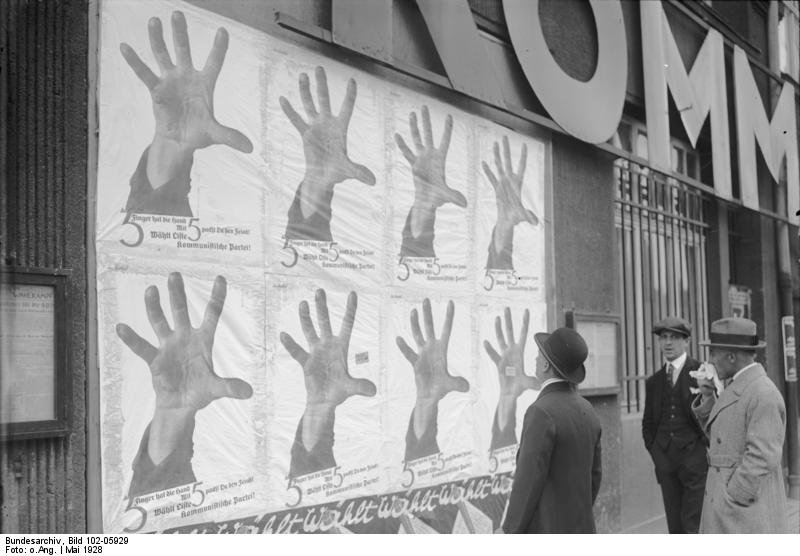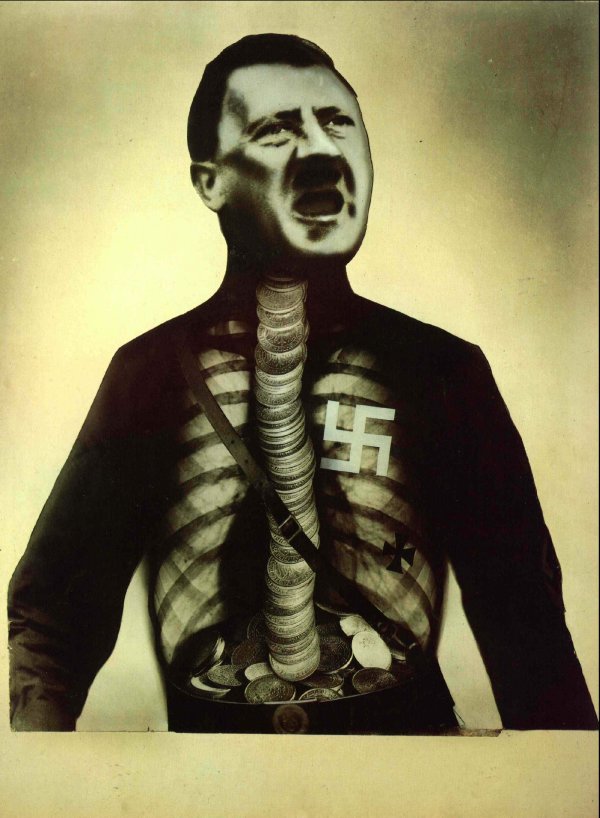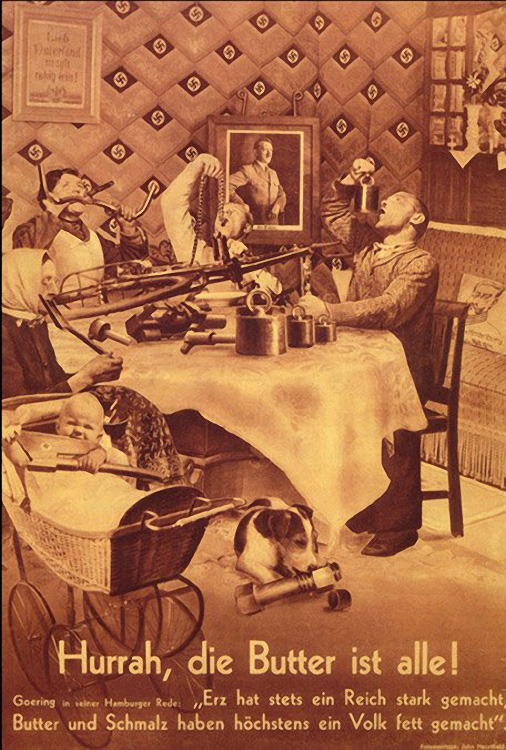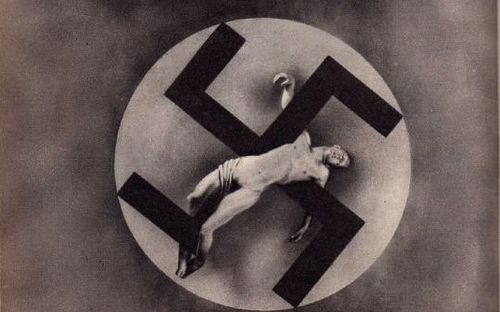<Back to Index>
- Artist John Heartfield (Helmut Herzfelt), 1891
PAGE SPONSOR
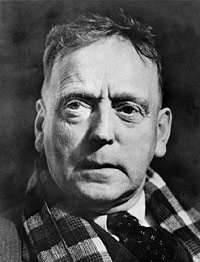
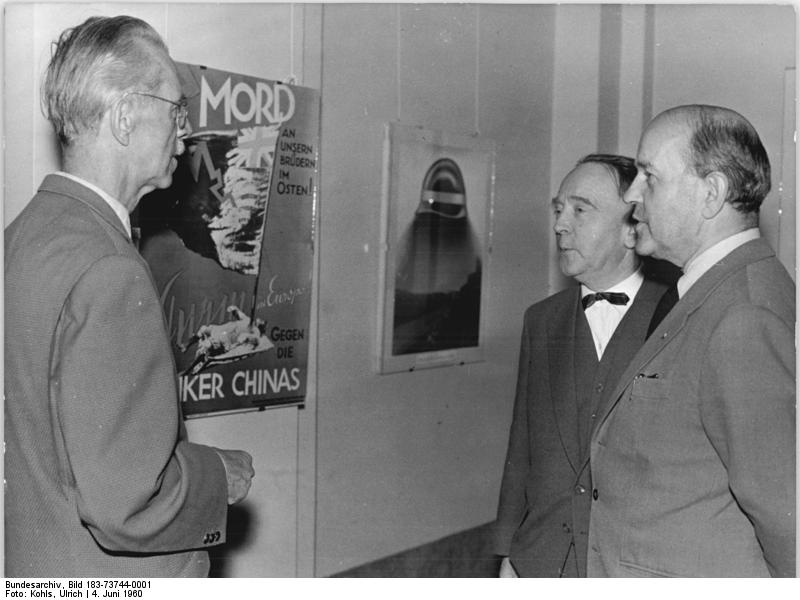
John Heartfield (born Helmut Herzfeld; 19 June 1891 – 26 April 1968) was a pioneer in the use of art as a political weapon. His photomontages were anti - Nazi and anti - Fascist statements. Heartfield also created book jackets for authors such as Upton Sinclair, as well as stage sets for such noted playwrights as Bertolt Brecht and Erwin Piscator.
John Heartfield was born "Helmut Herzfeld" on 19 June 1891 in Berlin - Schmargendorf. His father was Franz Herzfeld, a socialist writer, and his mother was Alice (née Stolzenburg), a textile worker and political activist.
Eight years later in 1899, Helmut, his brother, Wieland Herzfelde, and his two sisters, Lotte and Hertha, were abandoned in the woods by their parents. For a while, the four children resided with an uncle in the small town of Aigens.
Heartfield, along with his brother, Wieland Herzfelde (born Wieland Herzfeld) and George Grosz, launched the publishing house, Malik - Verlag in 1917.
In 1908, he studied art in Munich at the Royal Bavarian Arts and Crafts School. Two commercial designers, Albert Weisgerber and Ludwig Hohlwein, were early influences.
On the back of a photograph taken in 1912, he wrote his name "Helmut." In 1917, while living in Berlin, he Anglicized his name from "Helmut Herzfeld" to the English "John Heartfield" as a protest against anti - British fervor sweeping Germany. In 1916, crowds in the street were shouting, "Gott strafe England!" ("May God punish England!").
In 1920, John Heartfield and George Grosz experimented with pasting pictures together, a form of art later named "photomontage."
In January, 1918, Heartfield joined the newly founded German Communist Party (KPD).
In 1917, Heartfield became a member of Berlin Club Dada. Heartfield later became active in the Dada movement, helping to organize the Erste Internationale Dada - Messe (First International Dada Fair) in Berlin in 1920. Dadaists were the young lions of the German art scene, provocateurs who disrupted public art gatherings and ridiculed the participants. They labeled traditional art trivial and bourgeois. Heartfield was a member of a circle of German titans that included Edwin Piscator, Bertolt Brecht, Hannah Hoch, and a host of others.
Heartfield built theater sets for Erwin Piscator and Bertolt Brecht. Using Heartfield's minimal props and stark stages, Brecht interrupted his plays at key junctures to have the audience to be part of the action and not to lose themselves in it.
In 1919, Heartfield was dismissed from the Reichswehr film service because of his support for the strike that followed the assassination of Karl Liebknecht and Rosa Luxemburg. With George Grosz, he founded Die Pleite, a satirical magazine.
Soon after Heartfield met Bertolt Brecht in 1924. John Heartfield is buried steps from Bertolt Brecht's Home.
Though he was a prolific producer of stage sets and book jackets, Heartfield's main form of expression was photomontage. Heartfield produced the first political photomontages. He mainly worked for two publications: the daily Die Rote Fahne and the weekly Arbeiter - Illustrierte - Zeitung (AIZ), the latter of which published the works for which Heartfield is best remembered.
In the Museum of Modern Art in New York hangs a George Grosz Montage entitled, "The Engineer Heartfield."
During the 1920s, Heartfield produced a great number of photomontages, many of which were reproduced as dust jackets for books such as his montage for Upton Sinclair's The Millennium.
Heartfield lived in Berlin until April 1933, when the National Socialists took power. On Good Friday, the SS broke into his apartment, and Heartfield escaped by jumping from his balcony. He walked around the Sudeten Mountains to Czechoslovakia.
In 1934 he montaged four bloody axes tied together to form a swastika to mock The Old Slogan in the "New" Reich: Blood and Iron (AIZ, Prague, March 8, 1934).
In 1938, he was forced once again to flee before the Nazi Army — this time to England — before the imminent German occupation of Czechoslovakia. He was interned for a time in England as an enemy alien. His health began to deteriorate. Afterwards, he lived for Hampstead, England. His brother Wieland was refused an English residency permit in 1939 and, with his family, left for the United States.
Following the war, Heartfield settled in East Germany, East Berlin, and worked closely with theater directors such as Benno Besson and Wolfgang Langhoff at Berliner Ensemble and Deutsches Theater.
He was greeted with suspicion by the Stasi (East German Secret Police) because of the length of his stay in England. He was denied admission into the East German Akademie der Künste (Academy of the Arts). He was unable to work as an artist and was denied health benefits. He was suspected of "collaboration" by the Stasi because of the amount of time he had lived in England and because his dentist was under suspicion.
Due to the intervention of Bertoldt Brecht and Stefan Heym, Heartfield was formally admitted to the East German Akademie der Kúnste (Academy of the Arts) in 1956. Although he subsequently produced some montages warning of the threat of nuclear war, he was never as prolific again.
In 1967, he visited Britain and began preparing a retrospective exhibition of his work, "photomontages", which was subsequently completed by his widow Gertrude and the Deutsche Akademie der Künste, and shown at the ICA in London in 1969.
John Heartfield died on April 26, 1968 in East Berlin, German Democratic Republic.
In 2005, the Tate Gallery, Britain held an exhibition of his photomontage pieces.
After Gertrude Heartfield's death, the East German Akademie der Künste took possession of all of Heartfield's surviving works. When the West German Akademie der Künste absorbed the East German Akademie der Künste, the Heartfield Archive became the property of the West German Akademie der Künste.
From April 15 to July 6, 1993, the second floor of the Museum of Modern Art, MOMA, in New York City was the American venue for an exhibition of Heartfield's original montages. The show was reviewed in The New York Times.
He is best known for the political montages he created during the 1930s to expose German Nazism. During the 1930s and 1940s, he created some of his most famous montages.
- Adolf, the Superman (published in the Arbeiter Illustrierte Zeitung [AIZ, Workers' Illustrated Newspaper], Berlin, July 17, 1932), used a montaged X-ray to expose gold coins in the Fuehrer's esophagus leading to a pile in his stomach as he rants against the fatherland's enemies.
- In Göring: The Executioner of the Third Reich (AIZ, Prague, September 14, 1933), Hermann Göring is depicted as a butcher.
- The Meaning of Geneva, Where Capital Lives, There Can Be No Peace (AIZ, Berlin, November 27, 1932), shows the dove of peace impaled on a blood soaked bayonet in front of the League of Nations, where the cross of the Swiss flag has morphed into a swastika.
- Hurrah, die Butter ist Alle! (English: Hurray, no more butter is left!) was published on the frontpage of the AIZ in 1935. A parody of the aesthetics of propaganda, the photomontage shows a family at a kitchen table, where a nearby portrait of Hitler hangs and the wallpaper is emblazoned with swastikas. The family — mother, father, old woman, young man, baby and dog — are attempting to eat pieces of metal, such as chains, bicycle handlebars and rifles. Below, the title is written in large letters, in addition to a quote by Hermann Göring during food shortage. Translated, the quote reads: "Iron has always made a nation strong, butter and lard have only made the people fat".
Heartfield's artistic output was prolific. His works appeared as covers for the Arbeiter Illustrierte Zeitung (AIZ, Workers' Illustrated Newspaper) from 1929 to 1933, a popular weekly whose circulation rivaled any magazine in Germany during the early nineteen thirties. During 1931 Heartfield's photomontages were featured monthly on the AIZ cover, an important point, because most copies of the AIZ were sold at newsstands.
It was through rotogravure — an engraving process whereby pictures, designs and words are engraved into the printing plate or printing cylinder — that Heartfield's montages, in the form of posters, were distributed in the streets of Berlin in 1932 and 1933.
His photomontages satirizing Adolf Hitler and the Nazis often subverted Nazi symbols such as the swastika in order to undermine their propaganda message.
Hurrah, die Butter ist Alle! served as the inspiration behind the song "Mittageisen" by Siouxsie and the Banshees; the song was re-recorded in German and released as a single with Heartfield's work as the cover art. The Swiss darkwave band Mittageisen (1981 – 1986) called themselves after this song title.
The band Blurt recorded a song called "Hurrah! Die Butter Ist Alle" on their 1986 album "Poppycock".
The British hardcore punk band Discharge used Heartfield's work "Peace and Fascism" for the cover artwork of their compilation "Never Again".
